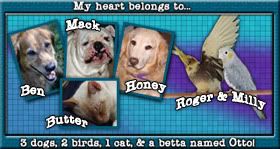They don't seem to have much on cats on CNN unfortunately, but this may be of interest to our many dog lovers:
Dog DNA shows influence of man
Thursday, May 20, 2004 Posted: 2:17 PM EDT (1817 GMT)
A genetic classification system for dog breeds may allow researchers to identify the genes that underlie specific traits.
WASHINGTON (Reuters) - The genetic differences that distinguish a Dachshund from a Doberman are so clear that a computer can tell breeds apart simply by looking at a dog's DNA, researchers said on Thursday.
A team scanning the genetic code of dogs for insight into human disease found a surprising 30 percent of genetic differences among dogs can be accounted for by a few hundred years of intense inbreeding - far more than the so-called racial differences between humans.
They were able to group 85 breeds of dog into four main genetic categories -- ancient breeds such as Huskies and Pekingese, which may be the closest to their wolf ancestors; hunting dogs such as Labradors; Mastiff-like breeds that include Rottweilers; and sheepdogs, collies and other herders.
"Most breeds have been artificially created by man," said graduate student Heidi Parker at the Fred Hutchinson Cancer Research Center in Washington, who worked on the study published in Friday's issue of the journal Science.
"Although all are members of the same species, this selective breeding has resulted in amazing variation between breeds with respect to weight, size, head shapes, coat, ear shape, behaviors and diseases."
Howard Hughes Medical Institute researcher Leonid Kruglyak said the number of tiny genetic differences within a single species is not seen in any other species.
Identifying single genes
For the past 300 years, people have intensively and systematically inbred dogs to get the traits they wanted - tiny lapdogs such as toy poodles, guard dogs, racing greyhounds and retrievers.
This is such a short time by standards of evolution that scientists expect that each distinctive trait has arisen from a small number of genes. This will make them easier to track down, researcher Elaine Ostrander predicted.
"There are more than 400 breeds of dog, and each is an isolated breeding population," Ostrander said in a statement.
"We're now looking at narrowing down similar regions of DNA to identify single genes that contribute to particular traits," Ostrander said. "There are hundreds of diseases out there, and many of them have counterparts in humans."
Doing this within genetically similar breeds of dog should be easier than trying to find genes accounting for cancer or heart disease amid a background cacophony of genes coding for traits such as fur color or leg length.
"Although there may be just as many genes for a given disease in dogs as there are in humans, being able to search for them in a single breed allows us to find the one or two genes responsible for that disease in that population much more easily," Ostrander said.
Her team sampled five unrelated dogs from each of 85 different American Kennel Club breeds.
"The dogs of a particular breed are much more similar to one another than they are to dogs of different breeds. These differences are so distinct that we could just feed a dog's genetic pattern into the database, and the computer could match it to a breed," Kruglyak said in a statement.
This was a surprise.
"It's a much more striking difference than is seen among human populations that evolved on different continents," he said.
So-called ancient breeds such as the Pharaoh Hound and the Ibizan Hound, as well as the Norwegian Elkhound, believed to be 5,000 years old, are no such thing, they also found.
"Our results indicate ... that these ... breeds have been recreated in more recent times from combinations of other breeds," the researchers wrote







 Reply With Quote
Reply With Quote
 I work for the Association that publishes the journal John, so I've been bombarded all day with people wanting a copy (Science isn't sold at any newstands). Thanks for the good eye.
I work for the Association that publishes the journal John, so I've been bombarded all day with people wanting a copy (Science isn't sold at any newstands). Thanks for the good eye. 

Bookmarks